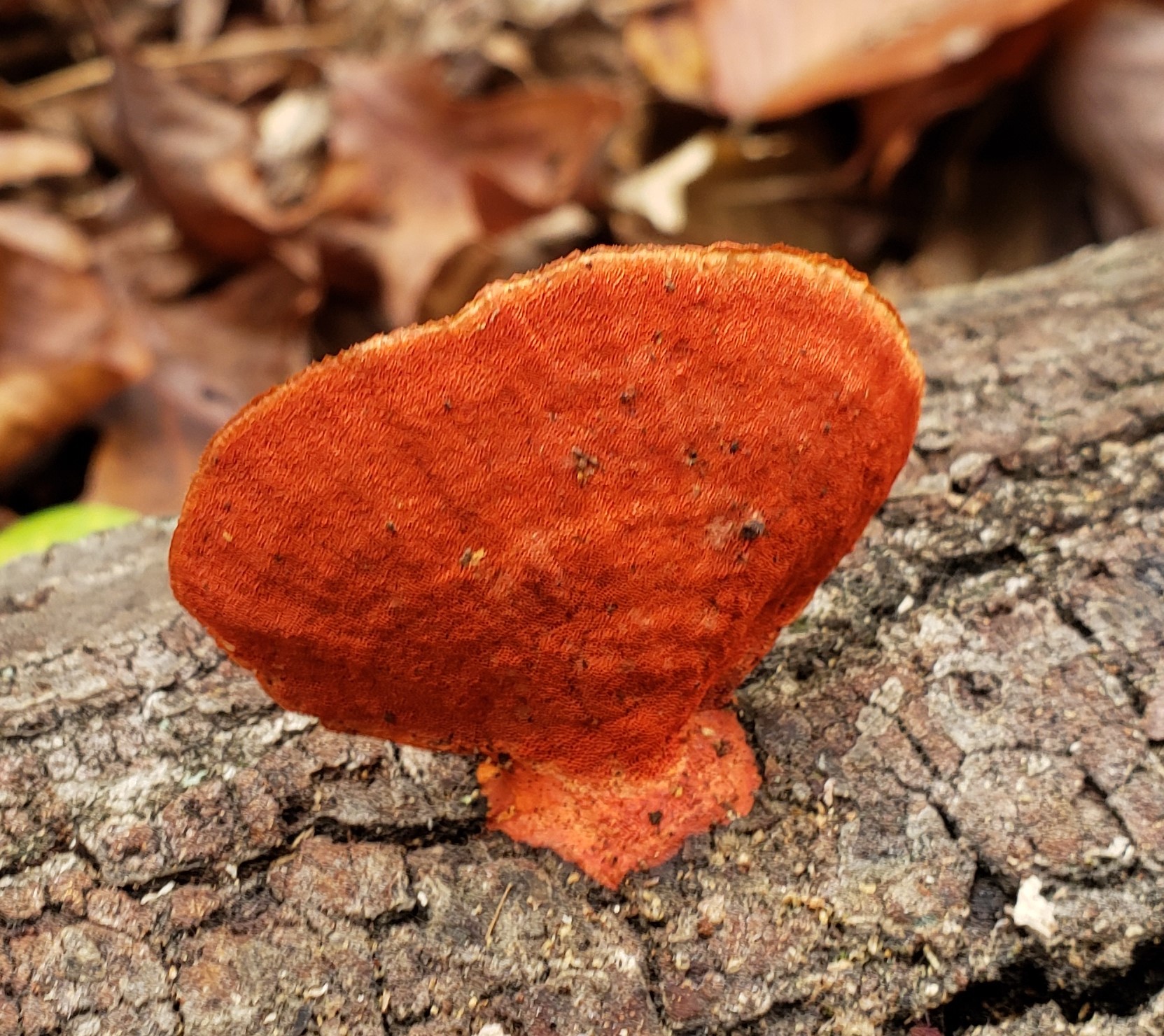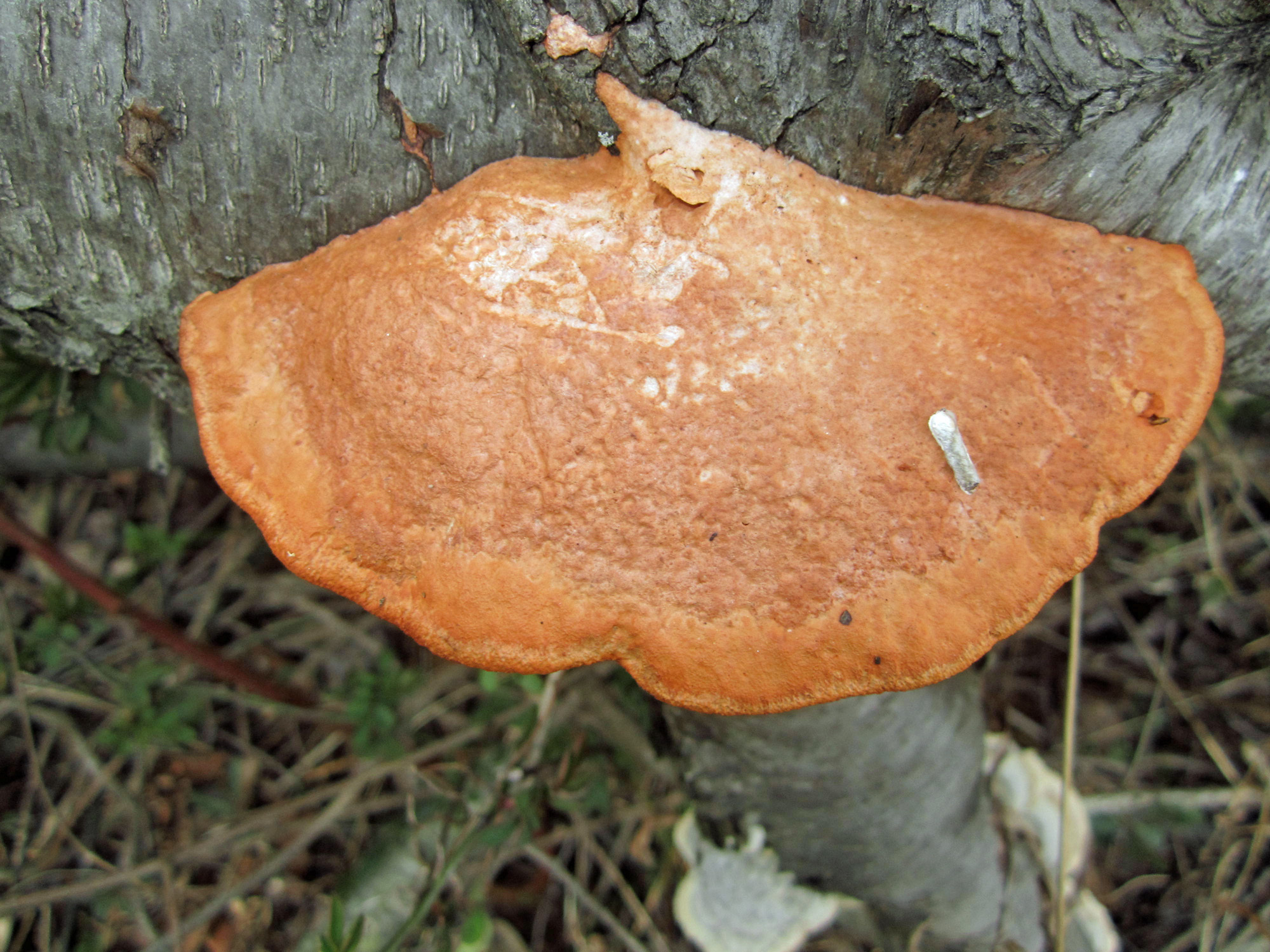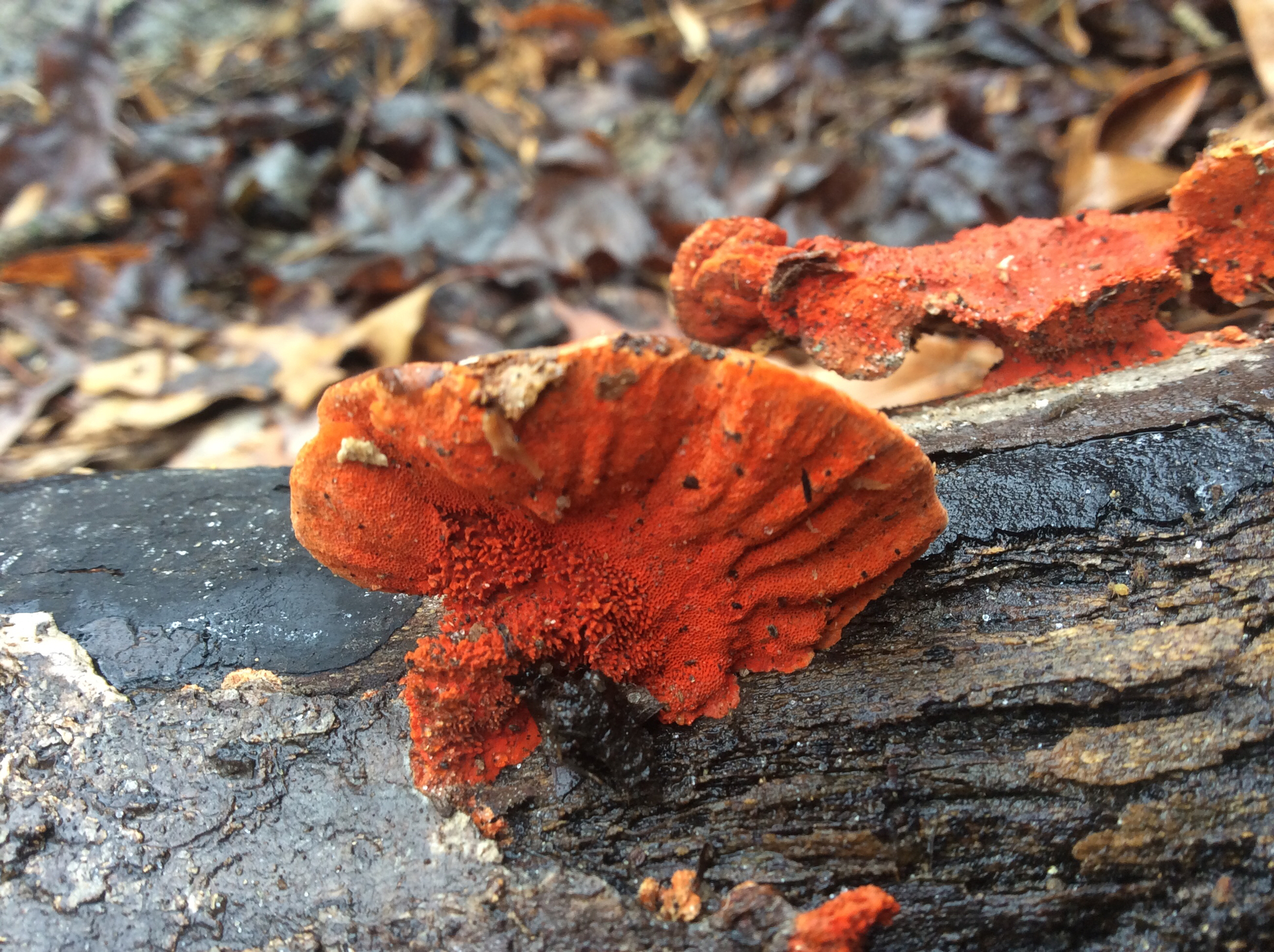Map Snapshot






















180 Records
Description
Fruiting body: Orange to reddish-orange (fades with age); smooth/wrinkled; fan to kidney-shaped; laterally attached; flesh fibrous, tough. Pores: Dark red-orange to orange, pore color usually brighter than dorsal side (J. Solem, pers. comm.).
Where To Find
Solitary, groups, overlapping clusters on decaying wood (J. Solem, pers. comm.).
Seasonality Snapshot
Eating mushrooms can be dangerous. One should do so only with expert advice and great care. MBP accepts no liability for injury sustained in consuming fungi or other biodiversity. Use of media featured on Maryland Biodiversity Project is only permitted with express permission of the photographer.
A Cinnabar Red Polypore in Baltimore Co., Maryland (12/31/2014).
View Record Details
Media by
Sue Muller.
Cinnabar Red Polypore in Frederick Co., Maryland (1/1/2019).
View Record Details
Media by
Robert Warren.
A Cinnabar Red Polypore in Montgomery Co., Maryland (11/1/2014).
View Record Details
Media by
David Hilmy.
Cinnabar Red Polypore (fertile surface) in Charles Co., Maryland (4/12/2009).
View Record Details
Media by
Richard Orr.
Cinnabar Red Polypore in Garrett Co., Maryland (5/12/2013).
Media by
Jim Brighton.
Cinnabar Red Polypore in Carroll Co., Maryland (4/22/2018).
View Record Details
Media by
Sue Muller.
Cinnabar Red Polypore in Prince George's Co., Maryland (10/28/2020). (c) Matthew Beziat, some rights reserved (CC BY-NC).
View Record Details
Media by
Matthew Beziat.
A Cinnabar Red Polypore in Baltimore Co., Maryland (9/20/2015). Identified by Paul Noell.
View Record Details
Media by
Keith Eric Costley.
A Cinnabar Red Polypore cross-section in Howard Co., Maryland (3/29/2018).
View Record Details
Media by
Joanne Solem.
Cinnabar Red Polypore in Garrett Co., Maryland (5/12/2013).
Media by
Jim Brighton.
Cinnabar Red Polypore in Howard Co., Maryland (3/29/2018). (c) Joanne and Robert Solem, some rights reserved (CC BY-NC).
View Record Details
Media by
Joanne Solem.
Cinnabar Red Polypore in Howard Co., Maryland (3/29/2018). (c) Joanne and Robert Solem, some rights reserved (CC BY-NC).
View Record Details
Media by
Joanne Solem.
Cinnabar Red Polypore in Anne Arundel Co., Maryland (6/22/2020). (c) Tony Futcher, some rights reserved (CC BY-NC).
View Record Details
Media by
Tony Futcher via iNaturalist.
Cinnabar Red Polypore in Montgomery Co., Maryland (6/14/2019). Determined by Jo Solem.
View Record Details
Media by
Anne Looker.
Cinnabar Red Polypore in Queen Anne's Co., Maryland (10/31/2020). (c) akidforthewild, some rights reserved (CC BY-NC).
View Record Details
Media by
akidforthewild via iNaturalist.
Cinnabar Red Polypore in Howard Co., Maryland (7/20/2013). Determined by Jo Solem.
Media by
Nancy Magnusson.
Cinnabar Red Polypore in Frederick Co., Maryland (5/30/2020). (c) dangitmimi, some rights reserved (CC BY-NC).
View Record Details
Media by
dangitmimi via iNaturalist.
Cinnabar Red Polypore in Montgomery Co., Maryland (6/14/2019). Determined by Jo Solem.
View Record Details
Media by
Anne Looker.
Cinnabar Red Polypore in Frederick Co., Maryland (1/4/2020). (c) Emilio Concari, some rights reserved (CC BY-NC).
View Record Details
Media by
Emilio Concari.
Cinnabar Red Polypore in Frederick Co., Maryland (1/4/2020). (c) Emilio Concari, some rights reserved (CC BY-NC).
View Record Details
Media by
Emilio Concari.
Cinnabar Red Polypore spores collected in Howard Co., Maryland (3/29/2018). Cylindric, smooth, hyaline; measured 5.6-6.8 X 2.6-3.3 microns.
View Record Details
Media by
Robert Solem.
Spores of Cinnabar Red Polypore in Howard Co., Maryland (3/29/2018). (c) Joanne and Robert Solem, some rights reserved (CC BY-NC).
View Record Details
Media by
Joanne Solem.
Cinnabar Red Polypore in Montgomery Co., Maryland (12/18/2016). (c) jhammock, some rights reserved (CC BY).
View Record Details
Media by
jhammock via iNaturalist.
Cinnabar Red Polypore in Montgomery Co., Maryland (12/18/2016). (c) jhammock, some rights reserved (CC BY).
View Record Details
Media by
jhammock via iNaturalist.
Cinnabar Red Polypore in Montgomery Co., Maryland (11/29/2019). (c) elaniobro, some rights reserved (CC BY-NC).
View Record Details
Media by
elaniobro via iNaturalist.
Cinnabar Red Polypore in Frederick Co., Maryland (1/5/2020). (c) Emilio Concari, some rights reserved (CC BY-NC).
View Record Details
Media by
Emilio Concari.
Source: Wikipedia
| Pycnoporus cinnabarinus | |
|---|---|

| |
| Scientific classification | |
| Domain: | Eukaryota |
| Kingdom: | Fungi |
| Division: | Basidiomycota |
| Class: | Agaricomycetes |
| Order: | Polyporales |
| Family: | Polyporaceae |
| Genus: | Pycnoporus |
| Species: | P. cinnabarinus
|
| Binomial name | |
| Pycnoporus cinnabarinus | |
| Synonyms | |
| |
| Pycnoporus cinnabarinus | |
|---|---|
| Pores on hymenium | |
| Hymenium attachment is not applicable | |
| Lacks a stipe | |
| Ecology is saprotrophic | |
| Edibility is inedible | |
Pycnoporus cinnabarinus, also known as the cinnabar polypore, is a saprophytic, white-rot decomposer. Its fruit body is a bright orange shelf fungus. It is common in many areas and is widely distributed throughout the world. It is inedible.[2] It produces cinnabarinic acid to protect itself from bacteria.[3]
The stipe and the pore surface had a positive reaction with potassium hydroxide.
References
[edit]Wikimedia Commons has media related to Pycnoporus cinnabarinus.
- ^ "Trametes cinnabarina". www.messiah.edu. Retrieved 6 June 2024.
- ^ Phillips, Roger (2010). Mushrooms and Other Fungi of North America. Buffalo, NY: Firefly Books. p. 304. ISBN 978-1-55407-651-2.
- ^ Eggert C. Laccase-catalyzed formation of cinnabarinic acid is responsible for antibacterial activity of Pycnoporus cinnabarinus. Microbiol Res. 1997;152(3):315-318. doi:10.1016/S0944-5013(97)80046-8

























